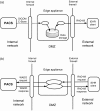Implementation methods of medical image sharing for collaborative health care based on IHE XDS-I profile
- PMID: 26835497
- PMCID: PMC4718444
- DOI: 10.1117/1.JMI.2.4.046501
Implementation methods of medical image sharing for collaborative health care based on IHE XDS-I profile
Abstract
IHE XDS-I profile proposes an architecture model for cross-enterprise medical image sharing, but there are only a few clinical implementations reported. Here, we investigate three pilot studies based on the IHE XDS-I profile to see whether we can use this architecture as a foundation for image sharing solutions in a variety of health-care settings. The first pilot study was image sharing for cross-enterprise health care with federated integration, which was implemented in Huadong Hospital and Shanghai Sixth People's Hospital within the Shanghai Shen-Kang Hospital Management Center; the second pilot study was XDS-I-based patient-controlled image sharing solution, which was implemented by the Radiological Society of North America (RSNA) team in the USA; and the third pilot study was collaborative imaging diagnosis with electronic health-care record integration in regional health care, which was implemented in two districts in Shanghai. In order to support these pilot studies, we designed and developed new image access methods, components, and data models such as RAD-69/WADO hybrid image retrieval, RSNA clearinghouse, and extension of metadata definitions in both the submission set and the cross-enterprise document sharing (XDS) registry. We identified several key issues that impact the implementation of XDS-I in practical applications, and conclude that the IHE XDS-I profile is a theoretically good architecture and a useful foundation for medical image sharing solutions across multiple regional health-care providers.
Keywords: IHE XDS-I profile; picture archiving and communication system; regional health-care services; solutions for image sharing and exchange.
Figures









Similar articles
-
Grid-based implementation of XDS-I as part of image-enabled EHR for regional healthcare in Shanghai.Int J Comput Assist Radiol Surg. 2011 Mar;6(2):273-84. doi: 10.1007/s11548-010-0522-8. Epub 2010 Aug 6. Int J Comput Assist Radiol Surg. 2011. PMID: 20694521
-
Medical Data GRIDs as approach towards secure cross enterprise document sharing (based on IHE XDS).Stud Health Technol Inform. 2006;124:377-83. Stud Health Technol Inform. 2006. PMID: 17108551
-
Long-term experience with setup and implementation of an IHE-based image management and distribution system in intersectoral clinical routine.Int J Comput Assist Radiol Surg. 2018 Nov;13(11):1727-1739. doi: 10.1007/s11548-018-1819-2. Epub 2018 Jul 11. Int J Comput Assist Radiol Surg. 2018. PMID: 29998400
-
[Cross-enterprise interoperability : Challenges and principles for technical implementation].Radiologe. 2020 Apr;60(4):334-341. doi: 10.1007/s00117-019-00626-9. Radiologe. 2020. PMID: 31828382 Review. German.
-
[The role of Integrating the Healthcare Enterprise (IHE) in telemedicine].Bundesgesundheitsblatt Gesundheitsforschung Gesundheitsschutz. 2015 Oct;58(10):1086-93. doi: 10.1007/s00103-015-2226-2. Bundesgesundheitsblatt Gesundheitsforschung Gesundheitsschutz. 2015. PMID: 26346898 Review. German.
References
-
- Zhang J., “DICOM image secure communication with internet protocols,” in Teleradiology, Kumar S., Krupinski E., Eds., pp. 33–46, Springer-Verlag Berlin Heidelberg; (2008).
-
- ACC/HIMSS/RSNA, “Integrating the healthcare enterprise cross-enterprise document sharing,” 2014, http://wiki.ihe.net/index.php?title=Cross-EnterpriseDocument_Sharing.

